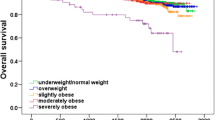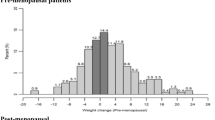Abstract
Purpose. Obesity and breast cancer are common conditions that often coexist. Concerns of relative overdosing of chemotherapy in the large cancer patient have led clinicians to apply empiric dose reductions, ‘cap’ the body surface area (BSA) at 2m2, or use ideal rather than actual body weight to calculate BSA. There are no data supporting or refuting these practices and their prevalence is unknown. We sought to determine the distribution of body size and prevalence of obesity in the breast cancer population of our cancer centre, and to determine clinician chemotherapy dosing practices in the era of modern adjuvant chemotherapy.
Patients and methods. Women with invasive breast cancer receiving systemic therapy at our institution between 1980 and 1998 were identified and their recorded height and weight were used to calculate BSA and body mass index (BMI). We reviewed the first cycle adjuvant chemotherapy dosing practices from 1990–1998. The ideal dose of chemotherapy was calculated based on calculated BSA, and then contrasted with the actual dose received at cycle one. Discrepancies were recorded and categorized, using the largest single drug reduction if more than one drug was reduced.
Results. Mean BMI in the systemic therapy population was 26.4±5.3kg/m2, 54% were overweight, 2% severely obese and 18% moderately so. Their mean BSA was 1.7±0.2m2 and only 5% had a BSA≥2m2. In the adjuvant chemotherapy subgroup, most patients received >85% of their ideal dose. The mean dose reduction was 5.3±11.3% versus 9.9±11.3% in the BSA <2 and >2m2 groups, respectively (p=0.02), and 4.3±8.2% versus 6.7±13.1% in the BMI <25 and ≥25kg/m2 groups, respectively (p=0.008). While only 24% of chemotherapy dose reductions of ≥15% were in the BSA ≥2m2 group, 76% were in the BMI ≥25kg/m2 group.
Conclusions. Obesity is prevalent in this breast cancer population. BSA is not a sensitive index of large body size. We consistently detected more frequent empiric dose reductions at cycle one of adjuvant chemotherapy, with reductions of greater magnitude in the largest women (BSA ≥2m2) and those who were overweight (BMI ≥25kg/m2).
Similar content being viewed by others
References
Goodwin PJ, Boyd NF: Body size and breast cancer prognosis: a critical review of the evidence. Breast Cancer Res Treat 16: 205-214, 1990
James WPT: The epidemiology of obesity. Ciba Found Symp 201: 1-11, 1996
Lau DCW: Call for action: Preventing and managing the expansive and expensive obesity epidemic. CMAJ: 503-506, 1999
Birmingham CL, Muller JL, Palepu A, Spinelli JJ, Anis AH: The cost of obesity in Canada. CMAJ 160: 483-488, 1999
Anonymous: Statistics Canada Report on the Health of Canadians. Ottawa, Health Canada, 1999
Powis G: Effects of disease states on pharmacokinetics of anticancer drugs. In: Ames MM, Powis G, Kovach JS (eds) Pharmacokinetics of Anticancer Agents in Humans. Amsterdam, Elsevier, 1983, pp 363-397
Anonymous: Canadian Cancer Statistics 1999. Toronto, National Cancer Institute of Canada, 1999
Anonymous: Statistics Canada General Society Survey-GSS 1991. Ottawa, Statistics Canada, 1991
Anonymous: Canada's Health Promotion Survey-HPS90. Ottawa, Health and Welfare Canada, 1993
Savarese DMF, Hsieh C-C, Stewart FM: Clinical impact of chemotherapy dose escalation in patients with hematologic malignancies and solid tumors. J Clin Oncol 15: 2981-2995, 1997
Budman DR, Berry DA, Cirrincione CA, Henderson IC, Wood WC, Weiss RB, Ferree CR, Muss HB, Green MR, Norton L, Frei III E: Dose and dose intensity as determinants of outcome in the adjuvant treatment of breast cancer. J Natl Cancer Inst 90: 1205-1211, 1998
Colleoni M, Price K, Castigliopne-Gertsch M, Goldhirsch A, Coates A, Lindtner J, Collins J, Gelber Rd, Thurlimann B, Rudenstam CM: Dose response effect of adjuvant cyclophosphamide, methotrexate, 5-fluorouracil (CMF) in node positive breast cancer. Eur J Cancer 34: 1693-1700, 1998
Rosner GL, Hargis JB, Hollis DR, Budman DR, Weiss RB, Henderson IC, Schilsky RL: Relationship between toxicity and obesity in women receiving adjuvant chemotherapy for breast cancer: results from CALGB study 8541. J Clin Oncol 14: 3000-3008, 1996
Bonadonna G, Valagussa P, Moliterni A, Zambetti M, Brambilla C: Adjuvant cyclophosphamide, methotrexate and fluorouracil in node positive breast cancer-The results of 20 years follow up. New Engl J Med 332: 901-906, 1995
Hryniuk W, Levine MN: Analysis of dose intensity for adjuvant chemotherapy trials in stage II breast cancer. J Clin Oncol 4: 1162-1170, 1986
Bonadonna G, Valagussa P: Dose response effect of adjuvant chemotherapy in breast cancer. New Engl J Med 304: 10-15, 1981
Tannock IF, Boyd NF, DeBoer G, Erlichman C, Fine S, Larocque G, Mayers C, Perreault D, Sutherland H: A randomized trial of two dose levels of cyclophosphamide, methotrexate and fluorouracil chemotherapy for patients with metastatic breast cancer. J Clin Oncol 6: 1377-1387, 1988
Bergh J: Tailored chemotherapy to equal toxicity: Is it possible? Recent Results Cancer Res 152: 328-340, 1998
Bergh J: Dose intensity in patients with metastatic breast cancer-time for novel thought? Ann Oncol 8: 109-110, 1997
Georgiadis MS, Steinberg SM, Hankins LA, Ihde DC, Johnson BE: Obesity and therapy related toxicity in patients treated for small cell lung cancer. J Natl Cancer Inst 87: 361-366, 1995
Findlay B, Myles J, Levine M, Bramwell V, Pritchard K, Ottoway J: Using ideal versus actual weights to calculate chemotherapy doses in premenopausal women with stage II breast cancer. Proc Am Soc Clin Oncol 13: 63a, A56, 1994 (abstr)
Saarto T, Blomqvist C, Rissanen P, Auvinen A, Elomaa I: Haematological toxicity: a marker of adjuvant chemotherapy efficacy in stage II and III breast cancer. Br J Cancer 75: 301-305, 1997
Mayers C, Panzarella T, Tannock IF: Adjuvant chemotherapy for breast cancer: The effects on survival of (I) inclusion in a clinical trial and (II) experiencing myelotoxicity. Proc Am Soc Clin Oncol 17: 117a, A450, 1998 (abstr)
The Scandinavian Breast Cancer Study Group: Results from a randomized adjuvant breast cancer study with high dose chemotherapy with CTCb supported by autologous bone marrow stem cells versus dose escalated and tailored FEC chemotherapy. Proc Am Soc Clin Oncol 18: 2a, A3, 1999 (abstr)
Pasulka PS, Bistrian BR, Benotti PN, Blackburn G: The risks of surgery in obese patients. Ann Intern Med 104: 540-546, 1986
Stadtmauer EA, O'Neill A, Goldstein LJ, Crilley PA, Mangan KF, Ingle JN, Brodsky I, Martino S, Lazarus HM, Erban JK, Sickles C, Glick JH: Conventional dose chemotherapy compared with high dose chemotherapy plus autologous hematopoietic stem cell transplantation for metastatic breast cancer. New Engl J Med 342: 1069-1076, 2000
Hortobagyi GN, Buzdar AU, Therialult RL, Valero V, Frye D, Booser DJ, Holmes FA, Giralt S, Khouri I, Andersson B, Gajewski JL, Rondon G, Smith TL, Singletary SE, Ames FC, Sneige N, Strom EA, McNeese MD, Deisseroth AB, Champlin RE: Randomized trial of high dose chemotherapy and blood cell autografts for high-risk primary breast carcinoma. J Natl Cancer Inst 92: 225-233, 2000
Peters W, Rosner G, Vredenburgh J, Shpall E, Crump M, Richardson D, Marks L, Cirrincione C, Wood W, Henderson I, Hurd D, Norton L: A prospective randomized comparison of two doses of combination alkylating agents as consolidation after CAF in high risk primary breast cancer involving ten or more axillary lymph nodes: Preliminary results of CALGB 9082/SWOG 9114/NCIC MA-13. Proc Am Soc Clin Oncol 18: 1a, A2, 1999 (abstr)
Lotz J-P, Cure H, Janvier M, Morvan F, Asselain B, Guillemot M, Laadem A, Maraninci D, Gisselbrecht C, Roche H: High dose chemotherapy with hematopoietic stem cell transplantation for metastatic breast cancer: Results of the French protocol PEGASE 04. Proc AmSoc Clin Oncol 18: 43a, A161, 1999 (abstr)
Rodenhuis S, Richel DJ, van derWall E, Schornagel JH, Baars JW, Koning CCE, Peterse JL, Berger JH, Nooijen WJ, Bakx R, Dalesio O, Rutgers E: Randomized trial of high dose chemotherapy and haemopoietic progenitor cell support in operable breast cancer with extensive axillary lymph node involvement. Lancet 352: 515-521, 1998
Hryniuk W, Bush H: The importance of dose intensity in chemotherapy of metastatic breast cancer. J Clin Oncol 2: 1281-1288, 1984
Hryniuk W: Dose intensity. In: Hryniuk W, Schilsky RL (eds) Principles of Antineoplastic Drug Development and Pharmacology. New York, Dekker, 1996, pp 263-279
Bryce CJ, Shenkier T, Gelmon K, Trevisan C, Olivotto I: Menstrual disruption in premenopausal patients receiving CMF (IV) versus AC adjuvant chemotherapy. Breast Cancer Res Treat 50: 284, A336, 1998 (abstr)
Crawford JD, Terry ME, Rourke GM: Simplification of drug dosage calculation by application of the surface area principle. Pediatr 5: 783-789, 1950
Pinkel D: The use of body surface area as a criterion of drug dosage in cancer chemotherapy. Cancer Res 18: 853-856, 1958
Grochow LB, Baraldi C, Noe D: Is dose normalization to weight or body surface area useful in adults? J Natl Cancer Inst 82: 323-325, 1990
Reilly JJ, Workman P: Normalization of anticancer drug dosage using body weight and surface area: is it worthwhile? A review of theoretical and practical considerations. Cancer Chemother Pharmacol 32: 411-418, 1993
Gurney H: Dose calculation of anticancer drugs: A review of the current practice and introduction of an alternative. J Clin Oncol 14: 2590-2611, 1996
Gurney HP, Ackland S, Gebski V, Farrell G: Factors affecting epirubicin pharmacokinetics and toxicity: Evidence against using body surface area for dose calculation. J Clin Oncol 16: 2299-2304, 1998
Reilly JJ, Workman P: Is body composition an important variable in the pharmacokinetics of anticancer drugs? Cancer Chemother Pharmacol 34: 3-13, 1994
Roubenoff R, Dallal GE, Wilson PWF: Predicting body fatness: The body mass index versus estimation by the bioelectrical impedance method. Am J Public Health 85: 726-728, 1995
Fuller NJ, Sawyer MB, Elia M: Comparative evaluation of body composition methods and predictions, and calculation of density and hydration fraction of fat-free mass, in obese women. Int J Obes Relat Metab Disord 18: 503-512, 1994
Desoize B, Robert J: Individual dose adaptation of anticancer drugs. Eur J Cancer 30A: 844-851, 1994
Author information
Authors and Affiliations
Rights and permissions
About this article
Cite this article
Madarnas, Y., Sawka, C.A., Franssen, E. et al. Are medical oncologists biased in their treatment of the large woman with breast cancer?. Breast Cancer Res Treat 66, 123–133 (2001). https://doi.org/10.1023/A:1010635328299
Issue Date:
DOI: https://doi.org/10.1023/A:1010635328299




